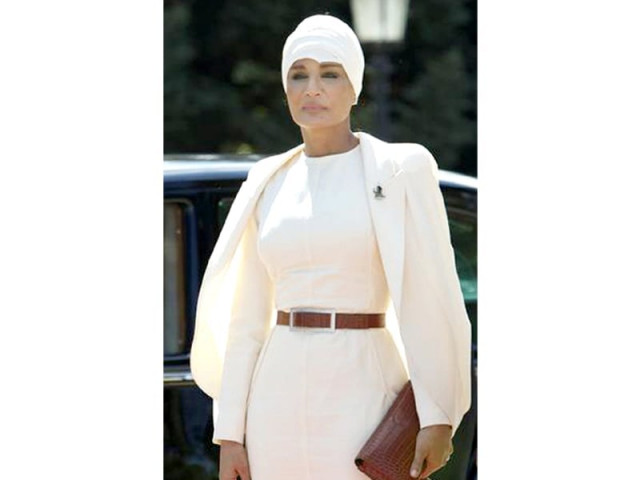
They’ve got university degrees, they promote humanitarian causes and live lives of ample luxury, all in the public eye. These modern-day Arab women, who’ve either married or been born into royalty, also rule the glamour stakes from their influential positions. Their unique styles and strong views have modernised the ‘face’ of contemporary Muslim royalty.
Once upon a time, it was unheard of for Arab princess to feature prominently in the public sphere. Today, Saudi female royals have the liberty to wear dresses that show off their shapely calves and are even working with rock stars for poverty alleviation campaigns — making monarchies seem less outdated.
In Pakistan, it’s not always easy to get away with such daring styles in the public eye. Female politicians are obliged to don dupattas on their heads in public.Comparatively, many Middle Eastern women are more inclined to buy into international runway trends. The saying that women ‘dress to impress other women rather than men’ seems especially true at segregated Saudi wedding events, where ladies leave their abayas at the door and emerge in shimmering designer gowns slit to the thigh with plunging necklines, dripping with jewels the size of pigeon’s eggs.
The turban-chic Sheikha — Mozah bint Nasser Al Missned of Qatar
Having studied Sociology at the University of Qatar, she now runs the Qatar Foundation and spearheads the Al Jazeera Children TV channel and the Qatar Luxury Group. The 60-year old, Sheikha Mozah bint Nasser Al Missned of Qatar is the second of the three wives of the Emir Of Qatar, Hamad bin Khalifa Al Thani. She is widely regarded as one of the world’s best dressed women. An avid follower of couture, the Sheikha’s stylish interpretation of the hijab which is more turban-syle is eminently chic, terribly expensive and extremely glamorous.
Rocking the kaftan — Princess Lalla Salma of Morocco
This IT engineer has founded the Lalla Salma Association against Cancer and is a goodwill ambassador for World Health Organisation (WHO). Married to King Mohammed VI and mother of two, she frequently dresses in vivid silk kaftans belted at the waist at formal occasions, along with tailored suits and dresses during the day. Her elegant sister-in-law, Princess Meryem and her attractive daughter, Princess Sukaina are equally known for their glamorous fashion sensibilities — their kaftans at Monaco’s Royal Wedding were the most striking outfits among the dignitaries present.
Leading the couture clan — Queen Rania
With a bachelor’s degree in business from The American University of Cairo, she has worked at Citibank and Apple before her marriage. As a humanitarian, she has played an active role in Unicef, The World Economic Forum and the International Youth Foundation.
The 43-year-old queen married to King Hussein II whose sense of style has catapulted her to the global A-list as an international fashion icon. The queen favours knee-length dresses and jackets for her daytime appointments and gowns for the red carpet. Critics even found her better dressed than Carla Bruni-Sarkozy during the Jordanian visit to the Elysees Palace.
Pakistani-origin princess — Sarvath El Hassan of Jordan
Princess Sarvath El Hassan of Jordan pairs regal tiaras and tailored dress coats with her traditional saris and counts Rizwan Beyg among her designers of choice. Crown Princess for three decades, this Cambridge-educated, Taekwondo black belt holder has a distinguished Pakistani lineage. Her father, Mohammed Ikramaullah, served as Pakistan’s first Secretary of State of Foreign Affairs and her mother Begum Shaista Suhrawardy was one of Pakistan’s first female parliamentarians.
The couture princess — Ameerah Al Taweel
Ameerah Al Taweel is the head of the executive committee of the Al-Waleed bin Talal Foundation and has travelled to Pakistan for flood relief efforts. The 28-year-old Princess Ameerah Al Taweel is the fourth wife of notable billionaire Prince Al Waleed bin Talal Al Saud. Her ensemble at the British royal wedding is among her best couture looks, where she dressed from head-to-toe in stunning, custom-made Zuhair Murad ensemble.
Beauty — not just on the outside
Badiya: We’re very quick to get upset when Muslims are being treated badly, but I don’t see the same level of protest when Muslims treat non-Muslims badly.
Princess Badiya said in 2011 at an interview published in Emel magazine.
Ameerah: No matter how many great things Arab women do, we’ll always be judged as a country that suppresses women as we are the only country where women still can’t drive. We are not backwards; we’re just treated like second-class citizens.
Princess Ameerah said at the “The Today Show” in 2011.
Rania: There are 600 million girls shackled by housework or labour in factories; many fall victim to early marriage, sexual abuse and HIV. So I push for girls’ education so that their wages can go up.
Queen Rania says in a 2011 interview for Glamour magazine
Lalla Salma: There can be no political or institutional empowerment of women unless their rights are promoted and women become part of the development process.
Princess Lalla Salma says at a 2009 speech at the Higher Council of Arab Women.
Sheikha Mozah: There is nothing in our religion to prevent women’s political participation.
Sheikha Mozah said in a speech delivered at Rice University in 2007.
Published in The Express Tribune, February 19th, 2012.


















COMMENTS
Comments are moderated and generally will be posted if they are on-topic and not abusive.
For more information, please see our Comments FAQ